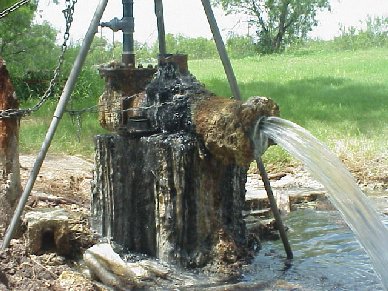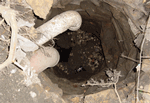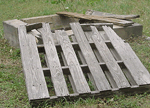Preserving & Protecting Resources
 |
| This abandoned well wasted as much as 300 gallons per minute for the last 70 years before being plugged. |
This project has had great success in protecting and preserving the area’s sources of water and improving the health and safety of many of the communities in and around the San Antonio area. The first well that was plugged at the beginning of the project was an artesian Edwards Aquifer well that had been flowing and wasting water for more than 70 years. This well was located in the southern part of San Antonio on the edge of the fresh /saline water line (or Bad Water Line). Due to the location of this well and its proximity to the Bad Water Line, it had a sulfur smell to it. The amount of water, approximately 300 gallons per minute, that flowed from the well also distributed the sulfur smell throughout the neighborhood. Once the well was plugged, the area’s air quality greatly improved. During the course of the project, a total of six Edwards Aquifer wells were plugged, and of the six, three were flowing wells, thus preserving millions of gallons of water.
 |
| Wells were cleaned and disinfected before sealing them, using pure cement to prevent contamination. |
The next group of abandoned wells that were plugged proved to be one of the highlights of the project. There were 10 abandoned wells identified that were located in a low-income neighborhood on Old Corpus Christi Road near Brooks Air Force Base and that were being used as septic systems by nearby residents. SAWS cleaned out and disinfected all the wells and plugged them using pure cement to prevent any further leaking of contaminants. All of the homes have been hooked up to sanitary sewer lines by the city.
 |
| Improperly secured, this well-posed a safety hazard for local residents. |
This action improved the sanitary conditions for the residents in the area and put a halt to the water quality degradation of the nearby San Antonio River.
As the project progressed, SAWS was also able to identify and plug many wells that posed a safety hazard in area neighborhoods. These hazards included old hand-dug wells that were found to be open at the surface or improperly secured. To the right is an example of one of the abandoned wells that were found and plugged. This well was open at the surface, 36 feet deep, and in the middle of a neighborhood.
Kelly Air Force Base
Midway through the project, an assessment of the abandoned and active wells located in the vicinity of the recently decommissioned Kelly Air Force Base was completed in response to contaminated groundwater in the area. Kelly Air Force Base was the oldest continuously active airfield in the U.S. Air Force. Since 1994, the Air Force has conducted annual, base-wide assessments to evaluate the effectiveness of ongoing remedial activities on the quality of the groundwater in the shallow aquifers.
To address the contamination, the Air Force constructed a groundwater treatment plant, below ground treatment devices, and plugged abandoned wells located on the base. Starting in December 2001, representatives from the Air Force Base, Greater Kelly Development Area, San Antonio Metropolitan Health District (SAMHD) and SAWS met to discuss the best approach to identify and plug the abandoned wells located off the base in the impacted area. Prior to this meeting, SAWS had identified approximately 40 abandoned wells in the Kelly vicinity through work related to the 319 Grant project, and these wells were included in the Air Force’s initiative. Representatives from Kelly, SAMHD and SAWS met on a weekly basis beginning in 2001 and continued through most of 2002.
During these meetings, site visits were conducted to investigate and identify abandoned wells and active wells. During the site investigations, staff had the opportunity to meet many of the residents in the Kelly area, which led to information about other potential well sites. Over a hundred potential sites were investigated and a total of 75 abandoned wells were identified. Of all the sites that were visited, only seven residents did not respond to initial or repeated requests to plug their wells. However, after a Notice of Violation was sent by SAWS, all seven residents agreed to let the Air Force plug their wells.
Between May-November 2002, all 75 wells were plugged. This has been an excellent opportunity for three agencies to work together to eliminate potential pollution and safety hazards in our community. Over the next few years, the Air Force, SAMHD and SAWS plan to meet to continue this process to identify and follow up on some of the sites that still need investigation. Should additional abandoned wells be identified, the Air Force will consider plugging them.
New Partnerships
 |
| Watershed Willie showing a picture of an abandoned well. |
Another important benefit of having such a proactive program is the support other agencies are willing to give. Over the course of the grant, SAWS also formed an alliance with the Alamo Resource Conservation & Development Organization, which contributed additional funding to the plugging of abandoned wells identified through the 319 Grant.
Community Involvement
Community involvement was also a key component in contributing to the project’s success. SAWS held or participated in many community outreach programs during the course of this project. We were able to generate several abandoned well investigations on information that was provided to us by some of the attendees. General source water protection was the key topic in public awareness promotions.